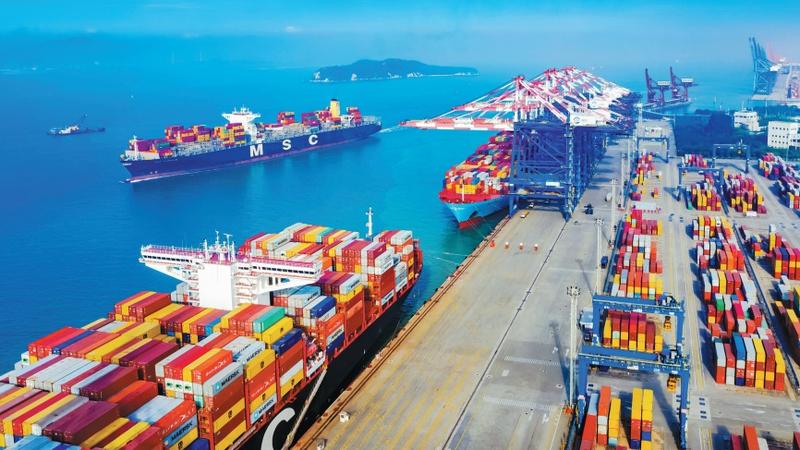 Containers await shipping at a port in Xiamen. (WANG XIEYUN / CHINA DAILY)
Containers await shipping at a port in Xiamen. (WANG XIEYUN / CHINA DAILY)
Security concerns faced by global shipping companies in the Red Sea maritime passage have imposed a financial burden on Chinese manufacturers and resulted in a shortage of available shipping containers in certain domestic ports, said analysts and exporters on Monday.
To prevent risks and protect their interests, several international shipping companies have announced the suspension of Red Sea routes. They have subsequently stated that the costs of rerouting vessels have led to an increase in transportation expenses, leading to adjustments to their freight rates.
For example, French shipping company CMA CGM increased the service rate for forty-foot equivalent units for all types of cargo shipments from Asia to the Mediterranean, raising it from $3,000 to $6,000, starting on Jan 15.
Prior to this, several shipping companies, including Denmark's Maersk Line, Germany's Hapag-Lloyd AG and Geneva-based Mediterranean Shipping Company SA, also announced that they imposed additional charges on this heavily affected route starting from Jan 1.
Wang Lan, a manager at the information department of the Shanghai Shipping Exchange, said as many container vessels are opting for the longer route around the Cape of Good Hope in South Africa, this choice has led to a decrease in both vessel and shipping container turnover efficiency, resulting in a short-term shortage of shipping capacity. Freight rates on routes from China to Europe, therefore, have increased.
As the main participants in the maritime shipping market, foreign trade companies are highly sensitive to changes in route freight rates. With varying degrees of price increases on the Red Sea route, Chinese exporters must spend more on shipping fees, said Xu Kai, chief information officer at Shanghai International Shipping Institute.
In the event that the Far East to Northwest Europe route and the Far East to Mediterranean route are compelled to take a detour around the Cape of Good Hope, the sea travel distances will experience an increase of 3,200 nautical miles (5,926.4 kilometers) and 6,400 nautical miles, respectively, said Jin Xiaomin, chairman of Zhejiang Kingston Supply Chain Group Co Ltd, a Yiwu, Zhejiang province-based exporter.
As a consequence of these changes, shipping fees between Ningbo-Zhoushan Port in Zhejiang and European ports, including Port of Hamburg and Port of Rotterdam, which were once slightly above $2,000, have now surged to over $6,000, he said.
Ding Yandong, president of Rollmax Shutter Component Co Ltd, a roller shutter component manufacturer based in Ningbo, Zhejiang, emphasized the need to effectively handle the operational aspects of orders already received from its clients and ready for shipment, as these responsibilities lie with the company.
Regarding new orders, Ding said Rollmax Shutter needs to calculate the unit price based on the new costs, and adjust the product's selling prices appropriately to absorb the additional expenses, ultimately to be borne by the buyers.
Many exporters seem to believe the increase in ocean freight costs can still be endured, but the lack of available slots is a problem as it means that a fully loaded container cannot be shipped out from the port, resulting in even greater losses, said Chen Hengde, president of Zhejiang Botai International Freight Forwarding Co Ltd, a Yiwu, Zhejiang-based freight forwarder.
He said some foreign trade companies have opted to "bypass" the Suez Canal and instead utilize land transportation in Dubai in the United Arab Emirates and Dammam in Saudi Arabia for delivering goods in the Middle East.
Contact the writers at zhongnan@chinadaily.com.cn


